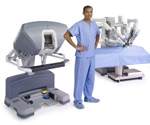Da Vinci Robotic Surgery Assistant System
What Is Da Vinci Surgery?
Da Vinci Robotic Assisted Surgery is a minimally invasive surgery that some surgeons are now using. There are many misconceptions out there about this type of surgery. This article will attempt to derail some of those myths.
First of all, what is Da Vinci Robotic Assisted Surgery? This is a minimally invasive surgery where the surgeon makes smaller incisions into your body rather than longer, more painful incisions. The incisions for Da Vinci can be as small as 1 or 2 cm rather than the 12 to 18 cm of traditional surgery. The benefits of this is that there is less surgical time and less recovery time, and possibly less time for infection to set in.
Da Vinci Surgery System

The Da Vinci Robot Operates On Its Own and Means an End To Human Surgeons
One of the misconceptions behind this type of surgery is that the Da Vinci system does the surgery on its own. This is not true. The Da Vinci system assists the surgeon to do the surgery. The system does not make a move with the surgeon. The system allows the surgeon to make more precise moves than he or she could do alone. It also magnifies the area being operated on, so the surgeon can better see what needs to be done. Blood vessels, veins, muscle and other parts of the body are magnified to lessen the opportunity for mistakes. This makes this type of surgery great for urological conditions such as blocked ureters and prostate issues, among other conditions. It also allows the surgeon to use smaller, more precise instruments to do the surgery.
There are those that believe that the Da Vinci surgery system means the beginning of the end for human surgeons. This is just not true at all. The Da Vinci system needs the surgeon – it cannot make a move without the surgeon. This is not a system that does anything on its. It is not a futuristic, science-fiction horror movie in the works. The system needs the surgeon to work. The system just allows the surgeon to use smaller incisions and smaller, more precise tools to do the work. This helps the surgeon and the patient by having less surgery time, less hospital time and less recovery time.
What Do You Think?
Would You Feel Comfortable With Da Vinci Surgery?
Da Vinci System Is Untested and Untried
Another myth is that the Da Vinci system is too new and therefore untried and untested in most surgeries. In fact, the Da Vinci system has been used more than 1.5 million times around the world. In surgeries that include gyneocological, urological, kidney, prostate and many other types of surgery in all parts of America and in countries around the world.
Da Vinci Robot is NOT the Terminator Robot!

Da Vinci Surgery Not Covered By Insurance
Some people believe that Da Vinci surgery will not be covered by their insurance. This type of surgery is covered by many insurance companies. Usually, if your insurance will cover minimally invasive surgery of other types, the Da Vinci system will be covered, as well. Medicare does cover this type of surgery because it requires less hospital time and less recovery time.
Da Vinci System is Virtual Reality
The Da Vinci system is not a “virtual reality” system, contrary to the belief of some. It provides a real time and real life view of the patient. The moves the system makes happen at the same time the surgeon makes them on the patient’s body. The surgeon is looking into the system rather than the patient, but it is all done in real time.
Risks of Da Vinci Robotic Assisted Surgery
There are dangers in this type of surgery – just as in any surgery. The biggest danger is that something can go wrong and the surgeon will have to revert to traditional surgery. This could happen for many reasons, including the surgeon not having enough insight to the surgical area. It could also happen if the surgeon makes some sort of mistake and needs to open the patient up to repair the mistake. Other dangers are very similar for any type of surgery. The patient may have reactions to the anesthesia or need a blood transfusion due to loss of blood. There could be problems that arise that mean the patient needs to be under the anesthesia longer than expected.
I Will Experience Da Vinci Surgery
Later this month, I will have surgery with this system. I have a ureter that needs repaired because it has become blocked due to scar tissue. The scar tissue is a result of a lifetime of kidney and urinary tract infections due to a horseshoe kidney. (In case you didn’t know, a horseshoe kidney is a condition in which, sometime before birth, the kidneys are connected by an isthmus resulting in a horseshoe shape, hence the name.) Because I do have a horseshoe kidney, my ureter is draped over the isthmus that connects my two kidneys. Right where the ureter drapes over the isthmus is where the blockage is. This makes traditional surgery very risky for me. I must travel to a university hospital to a specialist in this field because the surgeons in town have never done this type of surgery. The specialty surgeon has done four in his career – and that is considered a lot. Before I went to meet with the specialty surgeon, I did a lot of research on the Da Vinci system. I found lots of good reviews, and many bad reviews. I saw some negative stories on television news magazine shows and saw many advertisements from lawyers offering to sue surgeons who have used this system. Needless to say, I was scared out of my mind to have this surgery. Meeting with the surgeon was the best thing I could have done. He reassured me that the surgery was safe, and that all of the negative reviews come from just a few doctors who have had limited experience and refuse to keep up on the training for the system. This particular surgeon did his fellowship on this system and has continued his training for his whole career. He has used the system in more than one hundred surgeries and has had no problems with the “regular” surgeries. Out of the four surgeries done on patients with a horseshoe kidney, he had an issue with one of them. He had to revert to the traditional surgery and then things were fine after that. He completely put my nerves to rest. Well – as much as possible before any type of surgery!








